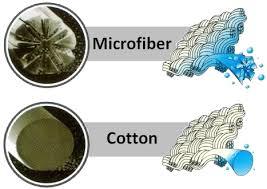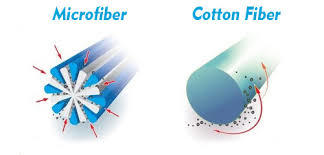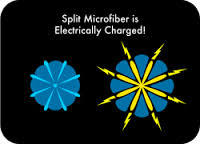this is in part related to http://windowcleaner.com/t/rags-microfibers-threadcount/37247
by@clean and i guess a continuation or expansion of it.
i have been confused about microfiber for some time. i heard of norwex cloths being able to clean windows spot free with only water years ago but had no first hand exposure to them. my first exposure was to the blue and green microfiber sold at costco a few years ago. these cloths were absolutely useless and i ended up giving them to our dog as chew toys-he loves them and i wish i could still get them for him.
this year i purchased some unger microfiber pads and a scrim.
the unger pads are not very absorbent and must be used with a minimum of solution or they just leave the window wet.
the scrim is quite absorbent.
this past weekend i decided i wanted to get the real scoop on microfober, why some work better and some not at all and the real goods on how to care for them. i spent several hours on line searching many websites including some i felt were filled with baseless personal opinion right thru to manufacturer sights with actual hard data.
below are my conclusions, opinions and what i believe at this time to be facts about microfiber.
factors determining quality/suitability:
the blend of polyester and polymides(nylon) determines the softness and plushness of the cloth, more polymide equals more plush more soft.
for the type of cleaning we do the fibres should be split.
the size of the fibres is HUUUUUGE (apply donald trump voice here) well actually the effect the fiber size is huge the fibers themselves are very small. some may be 1/5th the size of human hair to be considered “micro” BUT some are as small as 1/200th of a human hair and these are capable or removing not only dirt but also oil grease even bacteria!
gsm or grams per square meter is a pretty good indication of the number of fibers (fiber length could also affect gsm but longer fibers are also obvious to the eye. a weight of 600 gsm with have more absorbancy and dirt grabbing ability than one of 200 gsm (assuming the fibers are small enough and the polyester/polymide(nylon) blend is appropriate)
the knit or weave is the final factor and is more difficult to measure without testing for a specific purpose.
care:
washing with dish soap or laundry is fine, (do not include other materials to the same load as the microfiber will try to grab lint from the other fabrics)
hot water is fine, hot water is good.
extra rinse is good hot even better.
the dryer is fine and does NOT need to be set to low or fluff (do not include other materials to the same load as the microfiber will try to grab lint from the other fabrics)
BOILING is fine BOILING is good. boiling for ten minutes will get rid of soap residue, grease, oil etc and allows the fibers to relax, swell and release all the crap they are trying to hold onto.
no dryclean (as if we would!!!) NO bleach, No fabric softener (if you realize your detergent has fabric softener in it or you there was a bounce sheet already in the dryer wash again properly or boil.
so when you see a microfiber for 1.50 and for 15.00 you can bet the specs are not the same but it would sure be nice if manufacturers and re sellers had to list the specs wouldn’t it?
edit:
microfiber PADS have additional material like possibly foam or velcro. these additional materials can change the care. for example the unger cleaning pad has a max wash temp of 140f while the unger wash pad has a max wash temp of 190f so boiling is out.
edit:







